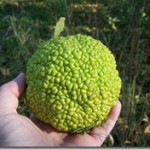Sure – a brisk walk may be more advantageous than a leisurely one for physical health, but sometimes a leisurely walk is better for mental health. You might even learn things – or at least find something to wonder about.
During a recent trip to Nashville [ask about our new grandbaby!], I often took advantage of a nearby walking trail, part of the Smyrna Greenway System.
One sunny Sunday afternoon five of us decided to hit the trail, which lent itself to what I would call a conversation walk.
I love conversation walks. You’re not just sitting and talking; you feel like you’re accomplishing something. You’re going somewhere, even if when you get there you turn around and come back. It takes little physical energy and even less mental energy.
Walking in a group also give us a chance to wonder out loud.
About Horse Apples, for instance…
 “What are those big green round bumpy things?”
“What are those big green round bumpy things?”
“I think they’re called horse apples.”
“Why do they call them horse apples? Is it because horses eat them?”
“Are they edible? Why do we see them on the ground all over the place, but rarely in the trees above?”
…Disc Golf…
As we strolled into the more open spaces of the trail, we noticed a strange-looking metal pole about five feet tall. Metal chains hanging from the top gathered above an open iron basket.
Signs along the way indicated this was an area designated for disc golf. Sure enough, we saw some golfers flinging Frisbees not only into the open spaces but through narrow forest corridors.
More questions.
I understood the baskets – they catch the Frisbees. But what are the chains for? If you throw the Frisbee into the chains, do you get more points? How big is the course?
Is it like throwing horseshoes? The closest one to the target wins? Or do you have to keep trying until you get it into the basket, just like “regular” golf?
…and a Red Caterpillar
We also came across a fat hairy reddish caterpillar crawling across the path. I don’t remember seeing a red caterpillar before – is that a color stage they all go through? [Duh. No.] Do certain types of butterflies come from different colors of caterpillars? [Yes, unless they’re moths.] Are they like squirrels – different colors in different parts of the country? [It’s an insect. My eyes start crossing when I get into too much bug research.]
The Cure for Temporary Ignorance
These questions may indicate that up until now, I haven’t been curious enough.
You know what, though? That’s okay! Because “at my age,” I’m beyond caring that I may sound ignorant. How will you know if you don’t ask – or at least Google it?
So this is my suggestion to you. Sure – walk for exercise. But even if you walk the same route every day, walk also for the discoveries you make along the way. Look up to see if you can find horse apples on the trees or – better yet – to find the source of a bird’s song. Look into the distance to catch a fleeting sunset – or to watch out for flying Frisbees.
Go ahead and look down, too. You may spot a caterpillar, just trying to survive until it morphs into a butterfly – or a moth – and can fly into the sky.
Answers?
No room here for the answers to my questions, except to tell you that horse apples are AKA hedge apples and osage oranges.
For more about disc golf, check out the Professional Disc Golf Association.
And caterpillars? Too many varieties for a simple answer, but I did find some pictures of some very colorful specimens: The Top 10 Most Beautiful Caterpillars.
Talk to me. What discoveries have you made on recent walks? When was the last time you engaged in a significant walk conversation?


The official name for the tree is bois d’arc, and it’s all over Texas and Oklahoma. “Bois d’arc is a small tree, Maclura pomifera, also known as the Osage-orange.
When early French explorers ventured west of the Mississippi River (New France and French Louisiana), they encountered the Osage Indians, who were known for making bows that were superior weapons for fighting and hunting. The unusual tree that the Osage used for making their bows was unknown to the French, who promptly called it bois d’arc, or “wood of the bow”[1].”
The first reference I found for it was actually an article trying to figure out how to kill it. One was growing in their lawn.
There you go…. more than you wanted to know. Our walking club had a member that would collect them to feed to her horses, which apparently is why they’re called “horse apples.”
P.S. Sean plays disc golf. He has a course near him.
About that osage bow, Yvonne? In my research, I came across that term, and immediately thought of an ornamental bow – one you would put on a package. When I followed the link, it was a how-to website on making osage bows for hunting. What a Duh moment – because, of course, the osage is a tree. I also found it interesting that one of the links I listed spells it “bodark,” while mentioning it’s a French term. Didn’t know what it meant, though. Thanks for that.
And regarding horses eating them? What I read suggests you have to be careful when feeding them to livestock, because they tend to get stuck in their throats. Maybe your walking club friend splits them open first.
Great, Yvonne! I can ask him all about it when I see him again. It looks like fun – lots of walking exercise, and a lot cheaper than golf, as in “free” in public parks like the one in Smyrna, except for the cost of your Frisbees, of course.
So, I have actually begun to finally realize walking is okay, and I like it…but then I have to be in the “Right” environment…preferably already outside and temperature over 60 degrees! ha
Yvonne made the comment to me about getting 15 minutes of “outside” sun or light to give me more Vit. D. I have to admit, I’d not thought of obtaining my Vit. D in that manner in a long time. [I use to tell my “students” we needed to go outside to get our Vitamin D and here I am forgetting that wisdom for myself!]
I enjoyed this blog, Cheryl, as usual of course. Now, if I could just read them when they come out!
Yes, Phyllis. Sometimes the weather just calls you to go outside and enjoy it. But today? January 24, 2010 in southwest Nebraska? Not so inviting. 31 degrees, wind at 31 miles an hour from the north. Really miserable. Good day for stair climbing and stretching instead, I guess.
Regarding the Vitamin D. Apparently real sunshine is the most efficient way to get it. Good for your bones, isn’t it? And of course, the walking is, too. Great combination.